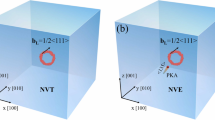Abstract
We studied damage evolution and the influence on defect interactions as a function of Si self implantation dose in p/p+ silicon wafers. Highly boron doped 150 mm diameter silicon substrate wafers with a 2.5 µm thick nominally un-doped epitaxial layer (p/p+) were employed. Due to the misfit strain, misfit dislocations formed during the epitaxial growth process around the wafer edges. This localized dislocation distribution was utilized to study the role of the implant on both the nucleation and growth of the misfit dislocation segments. Triple axis x-ray diffraction was used to determine changes to the strain in the layer due to both the implant and to subsequent annealing. Double axis x-ray topography combined with rapid thermal annealing was used to measure the nucleation and extension of the misfit dislocation segments after annealing. For the lower implantation dose (1012 cm-2) samples, the velocity of dislocations was reduced measurably and the density of newly formed misfit dislocations also decreased significantly relative to regions that received no ion implantation. A higher implantation dose reduced the nucleation and glide velocity further such that neither glide nor nucleation of new segments was detected. SIMS measurements confirmed that the interfacial lattice parameter grading was not appreciably different after an anneal step for the lower implant dose sample, but was measurable for the higher dose sample. In the latter case, transient point defect enhanced diffusion of boron was responsible for the grading. However, the lack of grading in the low dose sample indicates that interfacial grading did not significantly impede dislocation kinetics. This comparison indicates that it is the excess point defects that are produced during implantation that retard both the nucleation and extension of misfit dislocation segments.
Similar content being viewed by others
References
J. W. Matthews and A. E. Blakeslee, J. Crystal Growth 27, 118–125 (1974).
J. Fueller, M. Kunuma, J. Zipperich, and F. Banhart, Appl. Phys. A 69, 597–603 (1999).
S.-D. Kim, S. M. Lord, and J. J.S. Harris, J. Vac. Sci. Technol. B 14, 642–646 (1996).
S. Libertino, J.L. Benton, S. Coffa, and D.J. Eaglesham, Mat. Res. Soc. Symp. Proc. 504, 3–14 (1998).
R. Hull, J. C. Bean, J. M. Bonar, G. S. Higashi, K. T. Short, H. Temkin, and A. E. White, Appl. Phys. Lett. 56, 2445 (1990).
M. B. Stirpe, D. D. Perovic, H. L. Lafontaine, and R. D. Goldberg, Inst. Phys. Conf. Ser. 157, 127–130 (1997).
R. Hull, E. A. Stach, R. Tromp, F. Ross, and M. Reuter, Phys. Stat. Sol. (a) 171, 133–146 (1999).
P. Feichtinger, H. Fukuto, R. Sand hu, B. Poust, and M. S. Goorsky, in Thin Films-Stresses and Mechanical Properties VIII, Boston, MA, 1999 (Materials Research Society).
H. Fukuto, P. Feichtinger, G. D. U’Ren, S. Lindo, M. S. Goorsky, T. Magee, D. Oster, and J. Moreland, J. Crystal Growth 209, 716–723 (2000).
H. Holloway and S. L. McCarthy, J. Appl. Phys. 73, 103–110 (1993).
Author information
Authors and Affiliations
Rights and permissions
About this article
Cite this article
Feichtinger, P., Poust, B., Fukuto, H. et al. Ion Implantation Effect on Dislocation Propagation in Pseudomorphically Strained P/P+ Silicon. MRS Online Proceedings Library 610, 610 (1999). https://doi.org/10.1557/PROC-610-B6.10
Published:
DOI: https://doi.org/10.1557/PROC-610-B6.10




